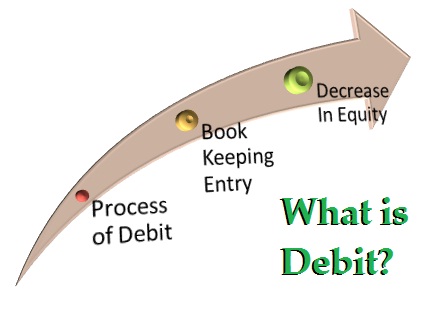Debit
The process of debit is a bookkeeping entry that leads in the decrease in an owner's equity or increase in asset or a decrease in a liability. The system
of debit entry has the opposite effect of a credit entry; which either increases a liability or owners equity or decreases an asset.

What is Debit?
The method of debit (or credit) intrinsically is neither negative nor positive for the company's financial situation. E.g., suppose the company finds cash (an assets), the system of debit is posted to the cash accounting, since a debit increases an asset value. Suppose the company finds a phone bill (this incurring an expense (loss); which decreases proprietors equity share), the system of debit is based to the utility expense accounting, since a debit decreases owners equity share.
Hence, instead of consider a debit as something either beneficial or badness, it is better to think of a debit entry as just a left-side book keeping ledger entry (the assets are recorded in the balance sheet on the left side) and a credit entry as a right-side book keeping ledger entry (wherever owners equity and liabilities can be ascertained).
Definition of Debit
The process of accounting entry which involves in either a decrease in liabilities or net worth or an increase in assets. Opposite of credit entry.
The system of debit is an accountancy term which involves an expense or money paid out from an account statement. Since each account statement i.e. debited, and another 1 is credited with the same amount. A debit shouldn't be confused with debt method; which is money we took over and must pay off.
Then, for debit an account involves to record a sum getting out of an account then record the same sum as getting in a different accounting. A debiting 1 account means crediting a different. And in the double-entry book keeping system we practice known as so for every business concern transaction affects 2 accountings:
1. A debit is recorded on the left side on the chart of accountings.
2. A credit on the right side on the chart of accountings.
Average Acceleration Calculator
Average acceleration is the object's change in speed for a specific given time period. ...
When an object falls into the ground due to planet's own gravitational force is known a...
In Mathematics, the permutation can be explained as the arrangement of objects in a particular order. It is an ordered...
A rectangle can be explained as a 4-sided quadrilateral which contains equal opposite sides. In a rectangle
A three sided polygon which has three vertices and three angles is called a triangle. Equilateral triangle...





